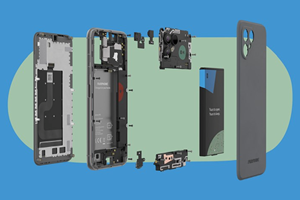Composite Drill Pipe An Available Option
Lincoln has been producing flexible composite drill pipe for short-radius, horizontal drilling since 1991. Its nominal 2.375 inch /60.3 mm (OD), 30 ft/9m long pipe shaft is filament wound with 12K carbon fiber combined with glass fibers in epoxy resin over an elastomeric liner. Standard API rotary shoulder too
Lincoln has been producing flexible composite drill pipe for short-radius, horizontal drilling since 1991. Its nominal 2.375 inch /60.3 mm (OD), 30 ft/9m long pipe shaft is filament wound with 12K carbon fiber combined with glass fibers in epoxy resin over an elastomeric liner. Standard API rotary shoulder tool joints, overwrapped with the composite material, form the end connections, enabling easy joining with same-size steel drill rods. The design was developed to enable “reentry” horizontal drilling from an existing borehole, says Lincoln’s Johnson. “The product has been a technical success, although this type of ‘slim hole’ drilling is not a large market.”
Equivalent steel re-entry drill pipe features articulated drill collars, which require high-pressure, internal rubber tubing for drilling mud containment. Plus, the articulated steel pipe requires special handling equipment and expertise at the drill site, and it is subject to frequent fatigue failures. “The torsional load is very high on rotary string pipe,” says Johnson. “Composite pipe can perform very well in this application.”
A robust larger-diameter composite drill pipe is on the horizon. The U.S. Department of Energy’s (DOE) National Energy Technology Center (NETL) is currently sponsoring a three-year development program for Cost-effective Composite Drill Pipe (CDP). Advanced Composite Products & Technology Inc. (ACPT, Huntington Beach, Calif.) has designed and produced a hybrid pipe (3.375 inch OD/1.625 inch ID) with a composite body and steel end connections. It will be field tested in 2002 by Terra Drilling in an onshore short radius application (i.e., directional drilling) in Oman. A 31.5 ft/9.6m section of the pipe weighs 76 lb/34.5 kg, has an ultimate tensile strength of 75,000 lb/34,000 kg and can withstand an ultimate torque load of 6,000 lb/2,720 kg. A larger 5.625 inch/135 mm (OD) version is currently under development and will be ready for testing in early 2003.
“CDP is projected to weigh less than half its steel counterpart, significantly increasing the lateral distance that can be reached from an offshore drilling platform as well as substantially increasing the depth of water in which drilling can be accomplished,” says Dr. James Leslie, chairman of ACPT.
The project initially specified the mechanical characteristics of 5.875 inch /147 mm (OD) high-strength steel drill pipe as performance targets. Current CDP specifications are 30 ksi/210 MPa compression strength, 478 ksi/3,200 MPa tensile strength, 11,000 psi/760 bar internal pressure, 6,500 psi/450 bar external pressure differential and ability to operate at a temperature of 350°F/176°C.
The composite body of the CDP is made by filament winding either 48K tow Panex 33 carbon fiber, supplied by Zoltek, or 12K T-700 fiber from Toray, wet out with a proprietary toughened epoxy resin, over a steel mandrel that includes the steel box and pin connections at each end of the pipe. The box and pin connections are supplied by Omsco (Houston, Texas), a drill pipe manufacturer and project partner. The pipe can be tailored to meet specific application loads, says Leslie. For example, more hoop fibers increase pressure capability, while more ±45º fibers improve torque capacity.
Embedded copper conductors and/or communication lines will be a key feature of the composite CDP, enabling transfer of power and/or real time data during drilling. The challenge is how to transmit the signal through the composite/metal joints. ACPT is investigating several approaches, including direct contact, acoustic transmission and inductive transmission. Several partner firms are researching each approach to determine the best solution.
The pipe’s mechanical performance has been extensively tested at coupon scale, one-third diameter scale, and on full-scale diameter/10 ft sections. The material demonstrated a reduction in high-temperature shear strength after exposure to moisture, as anticipated. ACPT is confident that the resin softening is only an issue with small coupons and should not present a problem at full-scale with protective wear layers in place. Favorable results from tension and torsion tests on the one-third scale and full-diameter, 10-ft sections indicate that performance requirements will be met.
ACPT reports that it is producing limited quantities of the smaller pipe for initial commercialization. Plans call for Omsco to manufacture the pipe in Houston once full production is underway.
Related Content
Composites end markets: Electronics (2024)
Increasingly, prototype and production-ready smart devices featuring thermoplastic composite cases and other components provide lightweight, optimized sustainable alternatives to metal.
Read MoreCombining multifunctional thermoplastic composites, additive manufacturing for next-gen airframe structures
The DOMMINIO project combines AFP with 3D printed gyroid cores, embedded SHM sensors and smart materials for induction-driven disassembly of parts at end of life.
Read MoreThe potential for thermoplastic composite nacelles
Collins Aerospace draws on global team, decades of experience to demonstrate large, curved AFP and welded structures for the next generation of aircraft.
Read MorePEEK vs. PEKK vs. PAEK and continuous compression molding
Suppliers of thermoplastics and carbon fiber chime in regarding PEEK vs. PEKK, and now PAEK, as well as in-situ consolidation — the supply chain for thermoplastic tape composites continues to evolve.
Read MoreRead Next
Design Issues With Risers And Drill Pipe
The design characteristics of composites make them good material candidates for both risers and drill pipe. The high strength-to-weight ratio of composites means that they can be fabricated to withstand the same hydrostatic collapse pressures as steel, at a much lower weight — as much as 65 percent less on a p
Read MoreVIDEO: High-volume processing for fiberglass components
Cannon Ergos, a company specializing in high-ton presses and equipment for composites fabrication and plastics processing, displayed automotive and industrial components at CAMX 2024.
Read More“Structured air” TPS safeguards composite structures
Powered by an 85% air/15% pure polyimide aerogel, Blueshift’s novel material system protects structures during transient thermal events from -200°C to beyond 2400°C for rockets, battery boxes and more.
Read More

























